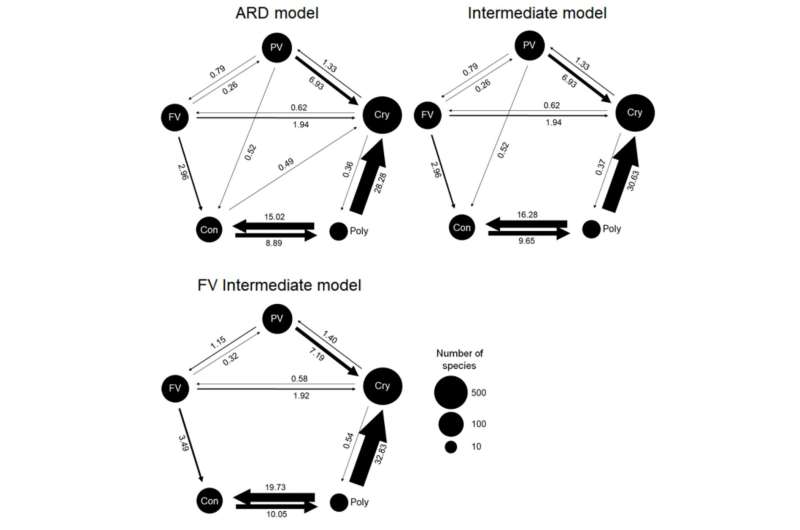The estimated transition rates among states from fits of the three color models that were better supported than the alternative models (Tables S1,2). These three models showed similar results except for a few transitions with very low estimated rates. The radius of each circle is proportional to the log-transformed number of species in the state. Arrow thickness reflects the estimated transition rates which are also given by the values listed next to each arrow (those transitions that are possible but not depicted have estimated rates not different from zero). Credit: Science (2023). DOI: 10.1126/science.ade5156
A trio of evolutionary biologists, two with Carleton University, the other with Seoul National University, has apparently solved the paradox of aposematism—how animals managed to evolve with bright colors to warn predators of their toxic nature. In their paper study, published in the journal Science, Karl Loeffler-Henry, Changku Kang and Thomas Sherratt, conducted an analysis of the family tree of over 1,000 frog, salamander and newt species.
For many years, evolutionary biologists have puzzled over the seeming paradox of aposematism, in which animals such as frogs develop bright colors to warn potential predators that eating them will make them sick or even kill them. How could such colors have evolved? Animals that stand out tend to be the first caught and eaten, preventing the evolution of even brighter colors from occurring. In this new effort, the research team set out to solve this riddle.
The work involved analyzing the family tree of 1,100 species of frogs, salamanders and newts, looking for evidence of evolution of aposematism in a new way—by breaking them down into more categories than previous efforts—five instead of two: conspicuous, cryptic, partially conspicuous, fully conspicuous and polymorphic.
They found that the ancestors of several species with aposematism had hidden colors, or in some cases, no color. In those with color, the ancestors had colors that could be displayed on demand. Such creatures tend to show their colors when fleeing, or as a signal. This, the researchers suggest, indicates that evolution of aposematism is likely a step-wise process.
A creature, such as a frog, first develops some amount of color as a signaling mechanism. Next, it develops a deterrent, such as warts that taste bad or venom that kills. Next, more color develops, and so on.
Eventually, a creature such as the dart frog evolves. Rather than attract predators, its neon bright colors warn of the serious risks involved in attacking or eating it. Just touching the skin of such a frog can bring serious repercussions, such as swelling, nausea and paralysis.
More information: Karl Loeffler-Henry et al, Evolutionary transitions from camouflage to aposematism: Hidden signals play a pivotal role, Science (2023). DOI: 10.1126/science.ade5156
Journal information: Science
© 2023 Science X Network
























